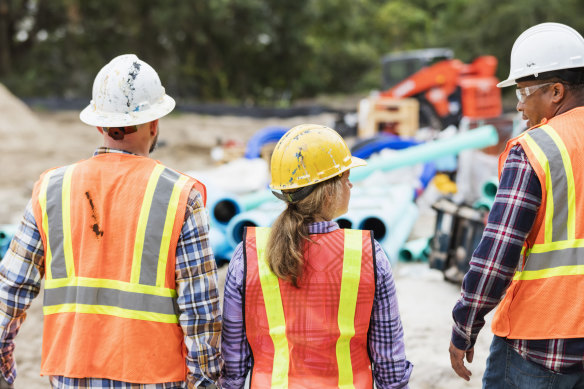This was published 5 months ago
‘No longer viable’ to build apartments in sprawling Perth
By Emma Young
Perth’s rate of apartment completions has collapsed to its lowest since records began in the 1980s, while the proportion of house-and-land package completions has reached an all-time high.
A new Property Council report released today says despite the state government’s target that 47 per cent of new developments in WA should be “infill” in already established areas, it only reached 31 per cent in 2022 – the rest being sprawl on the urban fringe.

Government projects are guzzling workers needed for housing, the property industry lobby says. Credit: Getty
Only 1.1 per cent of Perth homes are apartments, compared to Melbourne’s 3.8 per cent and Sydney’s 6 per cent.
To meet the housing targets set by the National Housing Accord, which aims to alleviate the national crisis, WA would need to be delivering five times the number of apartments per year it currently is, the Sky High report said.
But completion rates for infill developments are headed south; while about 2366 apartments are being completed this year, projected completions for 2025 fall dramatically to just over 600.
Starts this year and last year are also extremely low.
There are more than 10,000 apartments approved for WA but effectively on hold and unable to be constructed.
The report said the major issue was simply that projects were not financially viable; that, post-COVID in greater Perth, the cost of delivering an apartment was generally higher than the market was willing to pay, so projects simply didn’t stack up.
Currently, only luxury apartments and low-density greenfield sprawl were economically viable projects.
“While it doesn’t cost a lot less to build a smaller apartment in a less premium area, the price people are willing to pay is substantially less,” the report said.
“These more affordable developments simply can’t proceed in the current environment.
“Contrary to the common rhetoric, margins are not driven by ‘greed’; there are minimum thresholds necessary for securing project finance and managing risks.”
The report blamed the climbing and highly volatile construction costs driven by labour shortages and competition for labour from government and mining sectors.
It estimated that post-COVID construction costs had risen 30 per cent nationally, with even higher rises reported in WA, where infrastructure spending had more than doubled in the past five years thanks to major public works projects.
“Anecdotally, developers are reporting that construction estimates are now almost double the cost of similar developments five years ago,” the report said.
It anticipated costs would only climb as a new national construction code and bargaining agreements took effect.
The report argued that as households struggled and developers sat in “holding patterns”, state-based property tax revenue had doubled in five years to $4.5 billion and should be reinvested in housing initiatives, not more labour-guzzling government projects.
The report said the government needed to extend the current Infrastructure Development Fund rebates, review developer community contribution rules, review land taxes and make current transfer duty concessions for off-the-plan and under-construction developments permanent.
It also suggested the government consider offering incentives for skilled interstate workers to move to WA, removing local governments’ ability to apply public open space policies for infill developments in established areas, reform Keystart and delaying non-urgent projects.
The government on Tuesday morning announced more than 2000 free TAFE courses for the building trades to encourage a fresh supply to the construction industry.
Read more
Former Eagle Wirrpanda breaches restraining order; Toddler dies after routine surgery
Nervous about your teen at Leavers? Here’s how to start the conversation